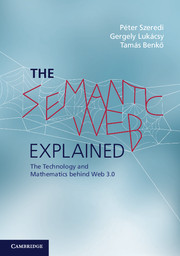2 - The Semantic Web and the RDF language
Published online by Cambridge University Press: 05 August 2014
Summary
The present chapter introduces the Semantic Web and its philosophy. This involves two main ideas. The first is to associate meta-information with Internet-based resources. The second is to reason about this type of information. We show how these two ideas can help in solving the problems mentioned in the previous chapter.
Having introduced the main concepts we continue the chapter by describing technologies that can be used for representing meta-information in a uniform way. First we introduce the XML language, which forms the basis of the Semantic Web as a standard information exchange format. Then we describe the RDF language; this has an XML notation as well as other representations and can be used to associate meta-information to an arbitrary resource. By doing this we can extend web contents with computer-processable semantics.
Subsequently, we introduce the RDF schema language, which provides the background knowledge that is essential to do reasoning on meta-information. We discuss the similarities and differences between RDF schemas and traditional object-oriented modelling paradigms.
We conclude the chapter by presenting several applications that directly or indirectly use RDF descriptions during their operation.
Introduction
The Semantic Web approach was originated by Tim Berners-Lee, the father of the World Wide Web and related technologies (URI, HTTP, HTML etc.). The approach is based on two fundamental ideas.
- Type
- Chapter
- Information
- The Semantic Web ExplainedThe Technology and Mathematics behind Web 3.0, pp. 52 - 121Publisher: Cambridge University PressPrint publication year: 2014



